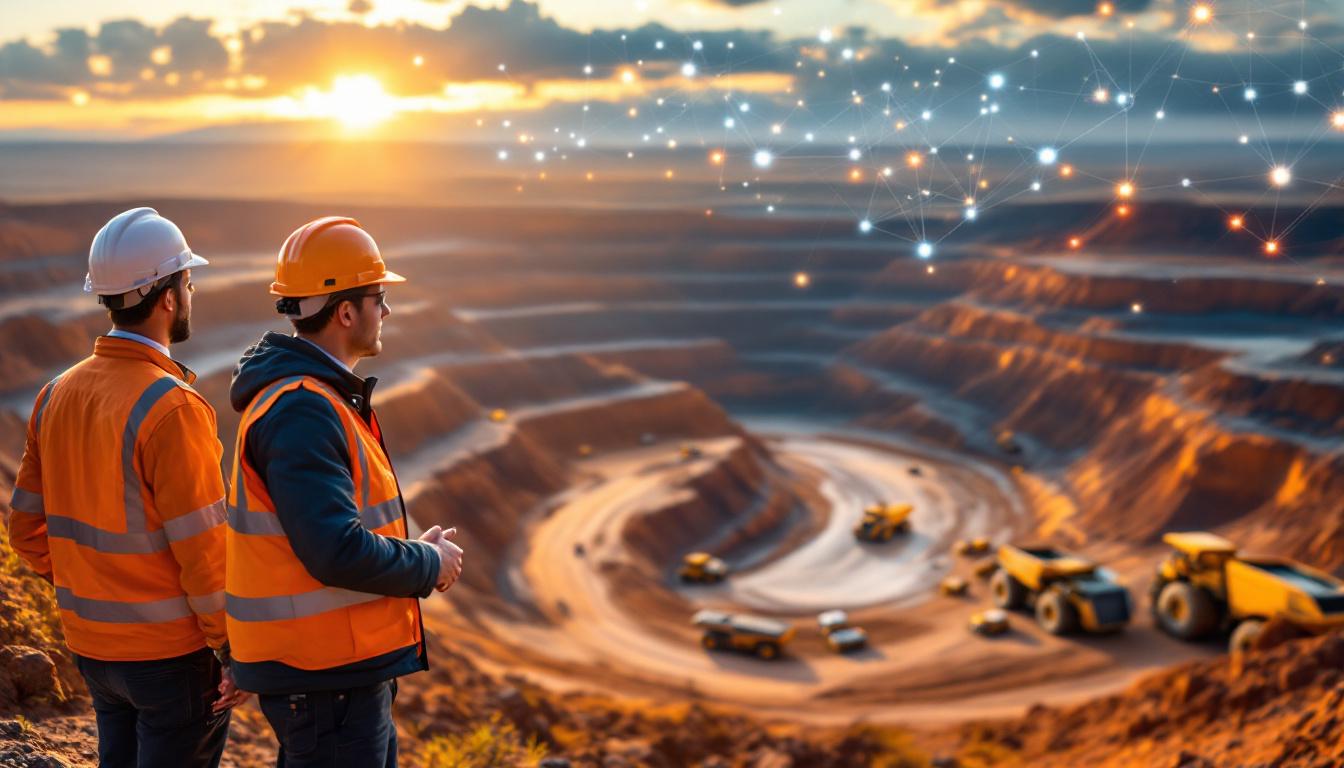What is the Donald Rare Earth Project and Why Does its Approval Matter?
The Donald Rare Earth Project, located in Victoria, Australia, represents a significant development in the global rare earth elements supply chain. Recently receiving its final major regulatory approval from the Government of Victoria, this project is poised to strengthen Australia's position as a key player in the critical minerals sector while addressing international supply chain vulnerabilities.
The Strategic Significance of Australia's Newest Rare Earth Development
The Donald Rare Earth and Mineral Sand Project marks an important milestone in Australia critical minerals reserve. This development comes at a crucial time when Western nations are actively seeking to diversify their rare earth supply chains away from traditional sources. The project's focus on extracting and processing rare earth elements positions Australia as a strategic partner in the global push for secure access to these vital resources.
Rare earth elements, despite their name, are relatively abundant in the Earth's crust. However, economically viable concentrations are scarce, and the technical challenges of processing these elements make new developments like the Donald Project particularly significant. These elements are classified as critical minerals due to their essential role in high-technology applications and the geopolitical risks associated with their supply.
Key Milestone: Final Regulatory Approval Secured
The Government of Victoria's recent approval represents the final major regulatory hurdle for the Donald Project. This critical achievement enables the joint venture partners to proceed with financing arrangements before making a final investment decision (FID), which is expected by the end of 2025.
With regulatory approvals now in place, the project timeline indicates that construction could begin shortly after a positive FID. According to project plans, production could commence as early as 2026, establishing a new source of critical minerals for global markets.
Mark S. Chalmers, President and CEO of Energy Fuels, emphasized the significance of this approval: "The work plan approval for the Donald Project is significant as it moves us one step closer to creating an important link between the United States and Australia on rare earths and critical minerals."
Who Are the Key Players Behind the Donald Project?
The Donald Project represents a significant international partnership between companies with complementary expertise and strategic objectives in the critical minerals sector.
The International Partnership Driving Development
The project is structured as a joint venture between:
-
Energy Fuels: A U.S.-based uranium and rare earth elements producer that can invest A$183 million ($119 million) plus $17.5 million in common shares to earn up to a 49% interest in the project. Energy Fuels brings significant experience in processing rare earth elements through its White Mesa Mill in Utah.
-
Astron: An Australian company that forms the other half of the joint venture and will retain a controlling interest of at least 51%. Astron contributes local expertise and knowledge of Australian mining regulations.
This partnership structure allows for shared risk and leverages the strengths of both companies—combining Australian mining expertise with American processing capabilities. Profits from the venture will be distributed proportionally to the partners' ownership interests, creating alignment in their objectives for project success.
Creating a US-Australia Critical Minerals Corridor
The Donald Project exemplifies the growing trend of cross-border collaboration in critical minerals development, particularly between allied nations seeking to secure supply chains. This US-Australia partnership aligns with broader government initiatives from both countries to strengthen cooperation on critical minerals.
By establishing a direct supply line from an Australian mine to a US processing facility, the project creates what could be described as a strategic minerals corridor between the two nations. This arrangement demonstrates how international partnerships can address shared challenges in securing access to critical minerals outside traditional supply channels.
What Will the Donald Project Produce?
The Donald Project will focus on extracting and processing valuable rare earth elements that are essential for numerous high-technology applications.
Phase One Production Targets and Timeline
With production expected to commence as early as 2026, the initial phase of the Donald Project will target:
- 7,000–8,000 tonnes per annum (tpa) of rare earth element concentrate (REEC)
- Significant quantities of neodymium-praseodymium (NdPr), terbium, and dysprosium oxides
This concentrate will consist of monazite and xenotime-bearing minerals, which are known for their relatively high concentrations of valuable rare earth elements. These minerals are particularly prized for their content of "magnet rare earths"—elements essential for the production of high-performance permanent magnets used in electric vehicles, wind turbines, and numerous other applications.
Phase Two Expansion Plans
Following successful implementation of the initial phase, the Donald Project plans a significant expansion:
- Increased production to approximately 13,000–14,000 tpa of REEC
- Enhanced capacity to meet growing global demand for critical minerals
The timing of this expansion will depend on market conditions, project performance, and strategic considerations. However, this phased approach allows the project to establish operations and generate revenue while preparing for larger-scale production as market demand continues to grow.
How Does the Donald Project Fit Into Global Rare Earth Supply Chains?
The Donald Project establishes a strategic minerals corridor between Australia and the United States, creating a secure supply chain for rare earth elements outside traditional channels.
The Mine-to-Market Strategy
The Donald Project employs an innovative cross-border processing strategy:
- REEC from the Donald Project will be shipped to Energy Fuels' White Mesa Mill in Utah
- The mill is undergoing a second phase expansion to process approximately 60,000 tonnes of REEC
- This expansion will enable production of an estimated 6,000 tonnes of isolated NdPr
- The Donald Project's output (13,000-14,000 tonnes) will utilize about 22-23% of the mill's total processing capability
This arrangement leverages existing processing infrastructure in the United States while accessing new mineral resources in Australia. Mark S. Chalmers explained: "Energy Fuels plans to import the rare earth minerals from the Donald Project into the USA, where we will process them into separated oxides at our mill in Utah for domestic and other customers."
Addressing Western Supply Chain Vulnerabilities
The Donald Project directly addresses one of the most significant vulnerabilities in Western technology supply chains: dependence on a limited number of sources for processed rare earth elements.
Currently, China dominates global rare earth processing, creating potential supply risks for industries reliant on these materials. By establishing an Australia-to-US supply chain, the Donald Project creates an alternative pathway for these critical materials to reach manufacturers of clean energy technologies, defense systems, and consumer electronics.
This diversification of supply sources enhances the resilience of global supply chains for rare earth elements, potentially reducing market volatility insights and ensuring more stable access to these materials for Western manufacturers.
Why Are the Donald Project's Rare Earth Elements Valuable?
The Critical Applications Driving Demand
Rare earth elements from the Donald Project will support numerous high-technology applications:
- Clean Energy Technologies: NdPr is essential for permanent magnets in wind turbines and electric vehicle motors
- Defense Applications: Terbium and dysprosium are used in precision-guided munitions, radar systems, and other military technologies
- Consumer Electronics: Various rare earths are vital components in smartphones, computers, and display screens
- Medical Equipment: MRI machines and other diagnostic devices rely on rare earth magnets
These applications represent growing markets with increasing material demands as societies transition to cleaner energy sources, advanced defense systems, and more sophisticated electronic devices.
What Makes the Donald Project's Resource Unique?
According to Energy Fuels CEO Mark S. Chalmers, the Donald Project possesses exceptional qualities that enhance its strategic value:
"We believe the Donald Project is exceptional, as it contains large quantities of the 'light', 'mid' and 'heavy' rare earth oxides needed for a variety of commercial, clean energy and defence technologies."
This diverse profile of rare earth elements is relatively uncommon. Many deposits contain predominantly lighter rare earths, while the Donald Project offers a more comprehensive range including the more valuable heavy rare earths like dysprosium and terbium. This diversity makes the project's output suitable for a wider range of applications and potentially more valuable in the marketplace.
What Economic and Environmental Factors Impact the Project?
Investment and Economic Benefits
The Donald Project represents a significant economic opportunity:
- Total investment: A$183 million ($119 million) plus $17.5 million in equity from Energy Fuels
- Job creation: Construction and operational phases will generate employment in Victoria
- Export revenue: Production of high-value mineral concentrates will boost Australia's export earnings
- Regional development: Economic activity in the project area will support local businesses and services
These economic benefits extend beyond the immediate project area, contributing to Australia's broader goals of developing its critical minerals sector and capturing more value from its natural resources.
Environmental Considerations and Management
Rare earth mining and processing present environmental challenges that must be carefully managed. The Donald Project's approval indicates that it has satisfied Victoria's environmental requirements, which typically address:
- Water management: Ensuring sustainable use and protection of water resources
- Waste handling: Proper management of processing residues and tailings, particularly important given that monazite often contains naturally occurring radioactive materials
- Land rehabilitation: Planning for post-mining restoration of the project area
- Emissions control: Minimizing air and noise pollution during operations
The project will operate under Australia's stringent environmental regulations, which are among the most comprehensive mining industry evolution frameworks globally. This regulatory framework helps ensure that rare earth production occurs with appropriate environmental safeguards.
How Does the Donald Project Connect to Broader Strategic Initiatives?
Energy Fuels' Complementary Partnerships
The Donald Project is part of a broader strategy by Energy Fuels to strengthen critical mineral supply chains:
- Energy Fuels has formed a strategic collaboration with Chemours Company
- This collaboration aims to capitalize on synergistic operational and geographic advantages
- These partnerships collectively enhance the security and diversity of rare earth supply chains
- The company's White Mesa Mill serves as a central processing hub for various rare earth sources
These interlocking partnerships demonstrate how companies are building more resilient supply networks through strategic alliances across multiple jurisdictions and resource types.
Supporting Clean Energy Transition Goals
The Donald Project directly supports clean energy transition objectives by:
- Providing essential materials for renewable energy technologies like wind turbines
- Supporting electric vehicle manufacturing through supply of magnet materials
- Enabling development of more energy-efficient electronic devices
- Reducing reliance on carbon-intensive supply chains
By establishing a secure supply of rare earth elements produced under stringent environmental standards, the project helps address the paradox of clean energy transition: the need for energy transition security through mining activities to produce the materials that enable cleaner technologies.
What Challenges and Opportunities Lie Ahead?
Navigating the Path to Production
Despite securing regulatory approval, the Donald Project still faces several challenges before reaching production:
- Finalizing financing arrangements before the final investment decision
- Managing construction costs and timelines in a competitive labor market
- Establishing efficient logistics for transporting concentrate from Australia to the US
- Navigating evolving regulatory requirements in both countries
How the joint venture partners address these challenges will significantly influence the project's timeline and ultimate success. The target of beginning construction after a positive FID (expected by end of 2025) creates a clear milestone for evaluating progress.
Future Expansion Possibilities
Beyond the planned phase two expansion, the Donald Project may have additional growth opportunities:
- Potential to target additional rare earth elements based on market demand
- Possibilities for downstream processing within Australia to capture more value
- Research and development initiatives to improve extraction and processing efficiency
- Exploration of adjacent areas to extend the project's resource base
These expansion possibilities will depend on initial project performance, market conditions, and strategic priorities of the joint venture partners.
Frequently Asked Questions About the Donald Rare Earth Project
How will the Donald Project impact global rare earth markets?
The Donald Project's contribution to global rare earth supply will help diversify sources beyond current dominant producers. While its initial output represents a relatively small portion of global production, the project's focus on high-value elements like NdPr, terbium, and dysprosium could have a more significant impact on those specific markets. The project may help moderate price volatility by providing a more stable and predictable supply source.
What technologies will benefit most from the Donald Project's output?
Electric vehicles and wind turbines will likely be the primary beneficiaries of the project's NdPr production, as these technologies require substantial quantities of permanent magnets. Defense systems will benefit from access to heavy rare earths like dysprosium, while various consumer electronics will utilize the broader spectrum of rare earth elements produced. As energy transition accelerates globally, demand from these sectors is expected to grow substantially.
How does the project compare to other Australian rare earth developments?
The Donald Project stands out among Australian rare earth developments due to its diverse rare earth profile including light, mid, and heavy rare earth oxides. Its international processing arrangement with Energy Fuels' White Mesa Mill also differentiates it from projects pursuing domestic processing. The project's focus on monazite and xenotime-bearing minerals provides a resource profile that complements other Australian developments targeting different rare earth mineral types.
What makes the international processing arrangement significant?
The decision to process Donald Project concentrate at Energy Fuels' White Mesa Mill in Utah creates several strategic advantages:
- Leverages existing processing infrastructure rather than building new facilities
- Establishes a secure supply chain between allied nations
- Utilizes Energy Fuels' expertise in rare earth separation
- Creates opportunities for supplying both US and international markets
This cross-border approach represents an innovative solution to the challenges of establishing new rare earth processing capacity, which typically requires significant capital investment and technical expertise and incorporates modern mine planning & ESG considerations from the outset.
Disclaimer: This article contains information about future projections and development plans that may be subject to change. Readers should not interpret this information as investment advice. Project timelines, production targets, and market impacts are based on company announcements and industry analysis as of June 2025.
Want to Discover the Next Rare Earth Success Story?
Stay ahead of ASX mineral discoveries like the Donald Rare Earth Project with Discovery Alert's proprietary Discovery IQ model, delivering real-time notifications on significant findings across Australia's mining sector. Explore historic returns from major mineral discoveries and position yourself for potential opportunities by visiting our dedicated discoveries page.




